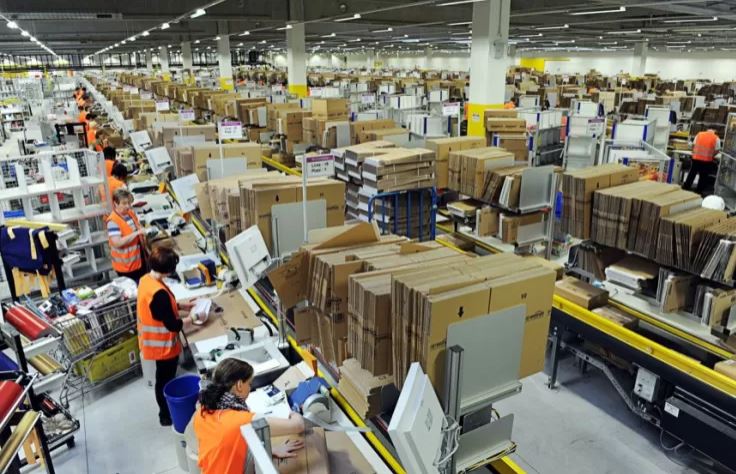Table of Contents
- 1 Amazon Shipping Delays – Vital Insights for Sellers
- 2 The Significance of Punctual Delivery for Sellers
- 3 The Repercussions of Delivery Delays on Amazon Sellers
- 4 Taking Preemptive Steps to Circumvent Amazon Shipment Delays
- 5 Your Shipment Encounters Delays – What’s the Next Course of Action?
- 6 Conclusion
 Fast and reliable delivery is a cornerstone of the Amazon shopping experience. When customers face delays, it can create frustration, because your customers wonder why does Amazon take so long to ship. That leads to negative reviews, and ultimately, lost sales.
Fast and reliable delivery is a cornerstone of the Amazon shopping experience. When customers face delays, it can create frustration, because your customers wonder why does Amazon take so long to ship. That leads to negative reviews, and ultimately, lost sales.
In a competitive marketplace like Amazon, reliable delivery is a key differentiator. Sellers who consistently deliver on time gain a trust advantage over those who experience frequent delays. Understanding and overcoming delivery challenges can give you a competitive edge.
During the Holiday Season, demand surges can lead to delays. By anticipating these trends and understanding the causes of delays, sellers can implement proactive measures to minimize their occurrence and ensure happier customers. Sellers can pre-stock inventory and choose faster shipping options to maintain timely deliveries.
In this post, we will give you insights into why are Amazon orders delayed and tell everything you need to know about Amazon shipping delays in 2024.
Amazon Shipping Delays – Vital Insights for Sellers
Amazon delayed shipping can occur for various reasons, and sellers need to be aware of the factors contributing to delays to effectively manage customer expectations and maintain a positive reputation on the platform. Delayed shipments happen, but understanding them is key to keeping your customers happy and your account healthy. The reasons for Amazon delivery delays are as follows.
Amazon shipping delays can occur for various reasons, and it’s essential for both sellers and customers to understand these factors. While Amazon strives for efficient and timely deliveries, several factors can contribute to shipping delays:
- High order volume: During peak seasons, promotions, or major sales events, the volume of orders on Amazon can surge. This increased demand can overwhelm shipping carriers and lead to delays in processing and delivering orders;
- Holiday Season and peak periods: During holidays or peak shopping periods, such as Black Friday or Cyber Monday, the demand for products increases significantly. Sellers, as well as shipping carriers, may experience challenges in keeping up with the heightened demand;

Peak season Amazon delivery
- Inventory issues: Sellers may face delays if they experience unexpected inventory shortages or if there are discrepancies between listed and actual stock levels. Inaccurate inventory management can result in delayed order fulfillment;
- Carrier capacity constraints: Carriers may have limitations on their capacity, especially during peak seasons. If demand exceeds available capacity, delays can occur as carriers work to manage and prioritize shipments;
- Technical glitches and system issues: Technical issues within Amazon’s systems or those of its third-party partners can lead to delays. This includes problems with order processing, labeling, or other technological aspects of the shipping process.
The Significance of Punctual Delivery for Sellers
Punctual delivery is crucial for sellers as it directly impacts their reputation and customer satisfaction. When a seller promises to deliver a product within a specific timeframe and fails to do so, it can lead to frustration and disappointment for the customer. This can result in negative reviews, reduced repeat business, and ultimately harm the seller’s brand image.
On the other hand, delivering on time can help build trust and loyalty with customers, leading to positive feedback, increased sales, and a strong reputation in the market. Therefore, punctuality should be a top priority for sellers who want to succeed in the competitive world of Amazon business.
- Customer satisfaction: Timely delivery is a fundamental aspect of customer satisfaction. When customers receive their orders promptly, it enhances their overall shopping experience, leading to positive reviews, repeat business, and word-of-mouth referrals;
- Positive reviews and ratings: Satisfied customers are more likely to leave positive reviews and high ratings. Positive feedback not only boosts a seller’s reputation on the platform but also influences the purchasing decisions of other potential customers;
- Buyer trust and loyalty: Punctual delivery builds trust between the seller and the customer. When customers trust that their orders will arrive on time, they are more likely to become loyal and make repeat purchases from the same seller.
- Reduced Order Defect Rate: Amazon tracks the Order Defect Rate (ODR), which includes metrics related to shipping and fulfillment. Timely delivery contributes to a lower ODR, positively impacting a seller’s performance metrics and eligibility for features such as the Buy Box.

Amazon tracks Order Defect Rate in your Seller Central
- Competitive advantage: Punctual delivery gives sellers a competitive edge. In a marketplace where customers have numerous choices, those sellers who consistently deliver on time are more likely to stand out and attract more business.
- Reduced customer service inquiries: Timely deliveries can help reduce the number of customer service inquiries related to order status and shipping. Proactive communication about delivery times and tracking information also contributes to a smoother customer service experience.
The Repercussions of Delivery Delays on Amazon Sellers
Delivery delays can have a significant impact on Amazon sellers. When a seller’s products are delayed in delivery, it can lead to negative reviews and ratings, which can harm their sales and reputation. Customers who experience delivery delays may also become frustrated and opt to purchase from a competitor instead.
Additionally, sellers may face penalties from Amazon for not meeting delivery deadlines, which can result in account suspension or even closure. Therefore, it is essential for Amazon sellers to stay on top of their delivery schedules and communicate effectively with customers to avoid any delays or issues.
- Negative customer reviews: Late deliveries often result in negative customer reviews. Unsatisfied customers are more likely to express their dissatisfaction through reviews, which can harm the seller’s reputation and discourage potential buyers;
- Lower seller ratings: Amazon tracks seller metrics, including the late shipment rate and order defect rate. Consistent delivery delays can lead to a higher late shipment rate, negatively impacting the seller’s overall performance metrics and potentially lowering their seller rating;
- Buy Box eligibility: The Buy Box is a highly coveted feature on Amazon, providing a significant competitive advantage. Sellers with better performance metrics, including on-time delivery, are more likely to win the Buy Box, boosting their visibility and sales;
- Customer return requests: Late deliveries may result in an increase in customer return requests. Buyers who receive their orders later than expected may be more inclined to return items, leading to additional logistical and customer service challenges for the seller;
- Reduced customer trust and loyalty: Delivery delays erode customer trust and loyalty. Buyers who experience late shipments may become hesitant to make future purchases from the same seller, leading to a potential loss of repeat business;
- Loss of competitive edge: In a competitive marketplace, punctual delivery is a distinguishing factor. Sellers who consistently experience delays may lose their competitive edge, as customers are more likely to choose sellers who can reliably deliver on time;
- Impact on brand image: Delivery delays can negatively impact the overall brand image of a seller. A brand associated with unreliable or slow deliveries may struggle to attract new customers and may face challenges in building a positive reputation.
Taking Preemptive Steps to Circumvent Amazon Shipment Delays
To preemptively address and circumvent Amazon shipment delays, sellers can take several proactive steps to optimize their fulfillment processes and enhance overall logistics efficiency. Here are key strategies to consider.
- Accurate inventory management: Maintain accurate and up-to-date inventory records. Regularly reconcile your physical inventory with your Amazon inventory to avoid overselling and potential delays caused by stockouts;
- Utilize Fulfillment by Amazon (FBA): Leverage Amazon’s Fulfillment by Amazon (FBA) service. With FBA, Amazon handles order fulfillment, including packing, shipping, and customer service. This can reduce the seller’s direct involvement in the shipping process, leading to more reliable and timely deliveries;

Amazon FBA fulfillment center
- Optimize order processing: Streamline internal order processing workflows to ensure quick and efficient handling of orders. Automation tools and software can help reduce manual errors and speed up the fulfillment process;
- Set realistic delivery expectations: Clearly communicate processing times, estimated delivery dates, and shipping policies on your product listings. Setting realistic expectations helps manage customer expectations and reduces the likelihood of dissatisfaction due to delayed deliveries;
- Monitor and adjust for peak seasons: Be prepared for peak shopping seasons, holidays, or promotions by monitoring and adjusting your strategies accordingly. Anticipate increased order volumes and work with carriers to ensure capacity during peak periods.
- Implement contingency plans: Develop contingency plans for unexpected events, such as natural disasters, strikes, or other disruptions that may impact shipping. Having backup fulfillment options or alternative shipping partners can help mitigate the impact of unforeseen challenges;
- Use shipping partners with tracking: Provide customers with tracking information for their orders. Use shipping partners that offer tracking services. That lets customers monitor the status of their shipments, reduces inquiries, and enhances the overall customer experience.
Your Shipment Encounters Delays – What’s the Next Course of Action?
If your shipment encounters Amazon delivery problems, taking prompt action is crucial to minimize the impact on your business and maintain customer satisfaction. Below are steps you can take when faced with shipment delays.
Step 1. Identify the cause of the delay: Investigate the root cause of the delay. Understand whether it’s due to issues within your own fulfillment processes, problems with a shipping carrier, or external factors beyond your control, such as weather-related disruptions;
Step 2. Update estimated delivery times: If you have information about the delay, update the estimated delivery times on your product listings. Setting clear and realistic expectations with customers can help manage their expectations and reduce dissatisfaction;
Step 3. Communicate proactively with customers: Send proactive and transparent communication to affected customers. Notify them about the delay, explain the reasons (if known), and provide a revised estimated delivery date. Clearly communicating the situation helps build trust with customers.
Step 4. Utilize Amazon Buer-Seller Messaging System: Use Amazon’s messaging system to communicate directly with customers. Address any concerns they may have and reassure them that you are actively working to resolve the issue and ensure their order reaches them;

Using Buyer-Seller Messaging to inform about shipping delays
Step 5. Contact the shipping carrier: If the delay is due to issues with the shipping carrier, contact them promptly to inquire about the status of the shipment. Request updates, and if possible, work with the carrier to expedite the delivery process.
Step 6. Evaluate and adjust fulfillment processes: Conduct an internal review of your fulfillment processes to identify any areas that may have contributed to the delay. Evaluate whether there are steps you can take to optimize and improve your processes to prevent future delays;
Step 7. Consider offering compensation or discounts: Depending on the severity of the delay and its impact on customers, consider offering compensation or discounts as a goodwill gesture. This can help mitigate customer dissatisfaction and demonstrate your commitment to customer satisfaction.
Conclusion
Ensuring timely delivery and excellent customer service is crucial for Amazon merchants, but they should also prioritize their product’s performance. Employing Amazon monitoring software is an effective approach to stay ahead of your sales. With SellerSonar, you receive immediate Amazon alerts that safeguard your sales. Our system keeps you informed of any changes to your listings, prevents Buy Box hijackers, tracks your keyword rank history, and notifies you of new or deleted reviews and product suppressions.
Take advantage of SellerSonar now. Sign up for our trial which lasts for 29 days and enhances your business journey on the platform.

